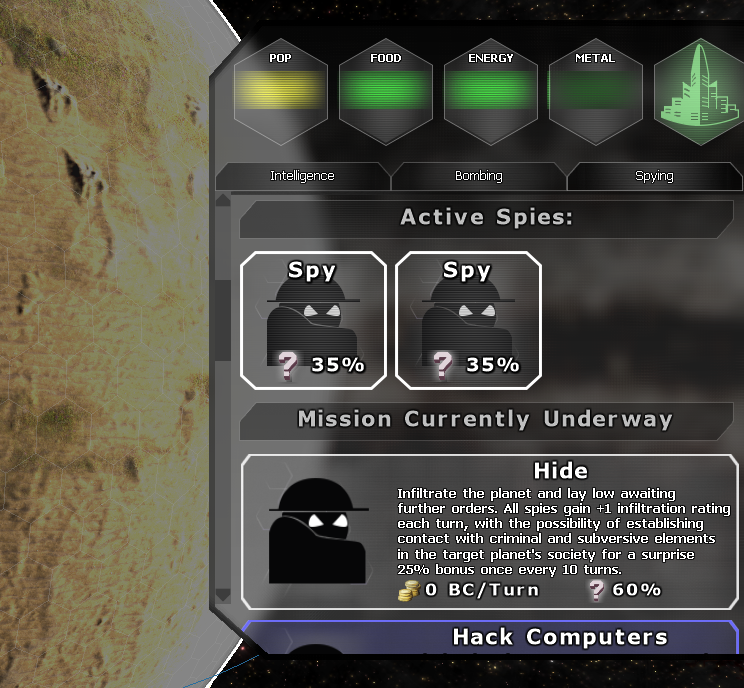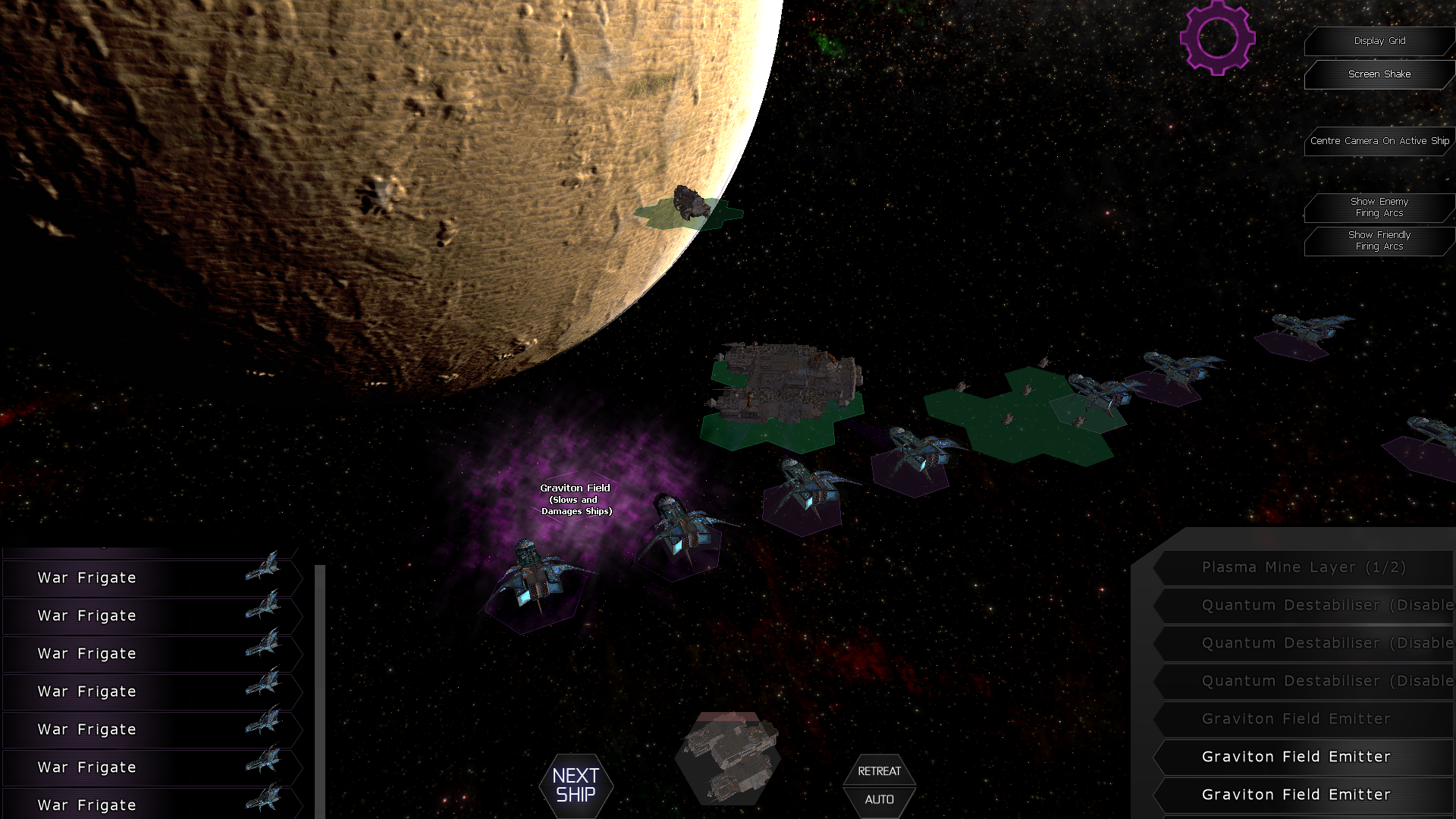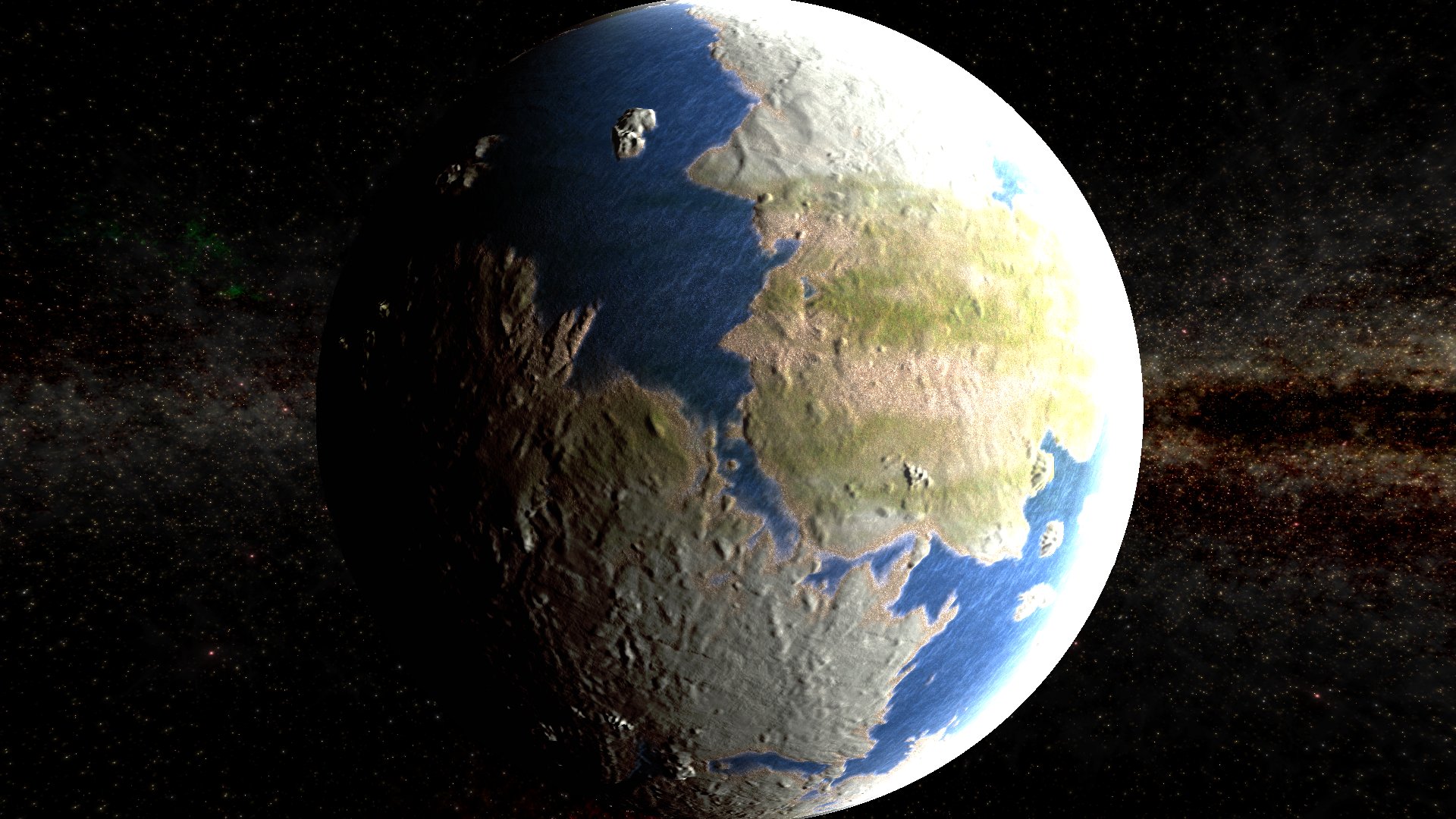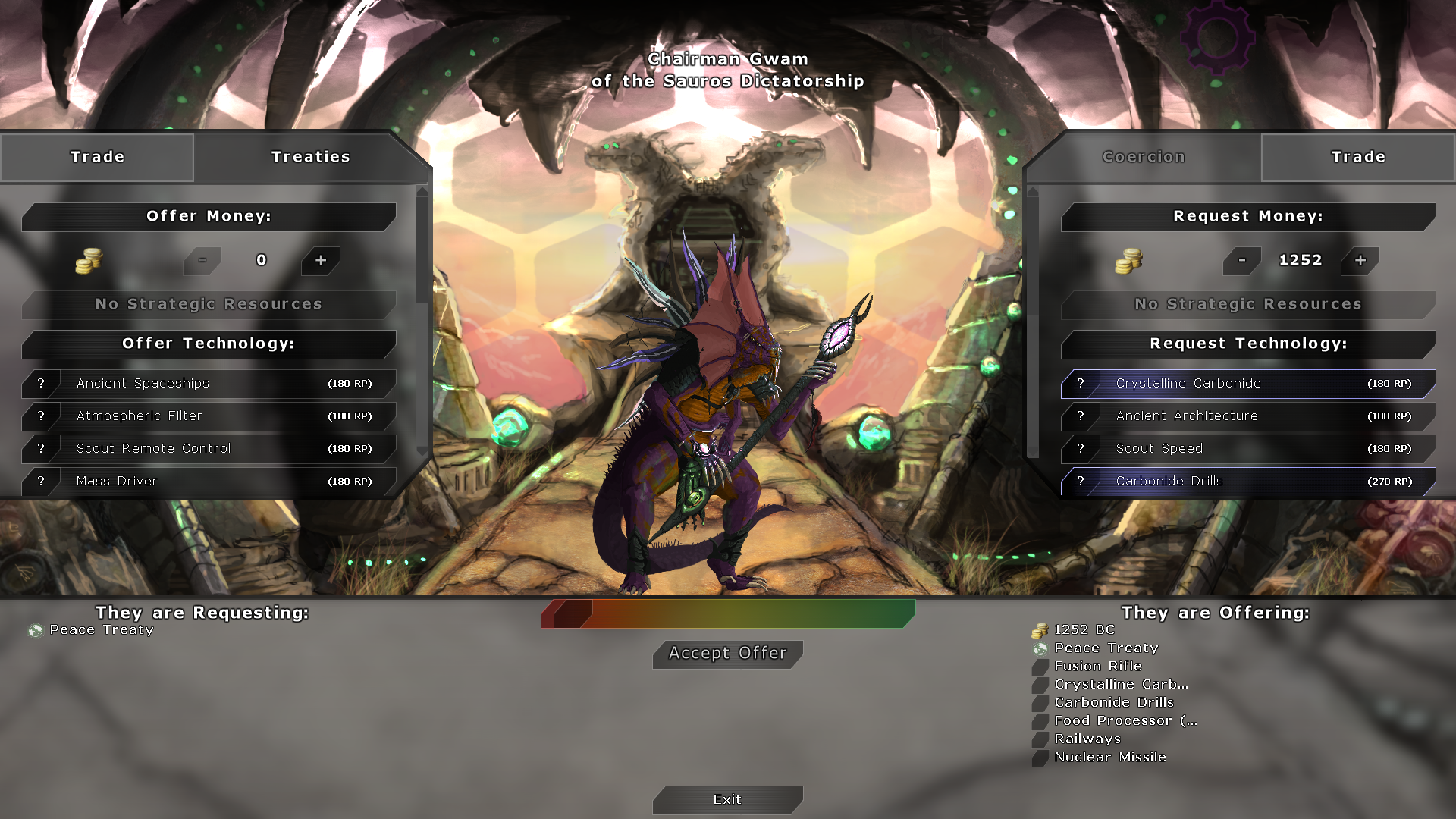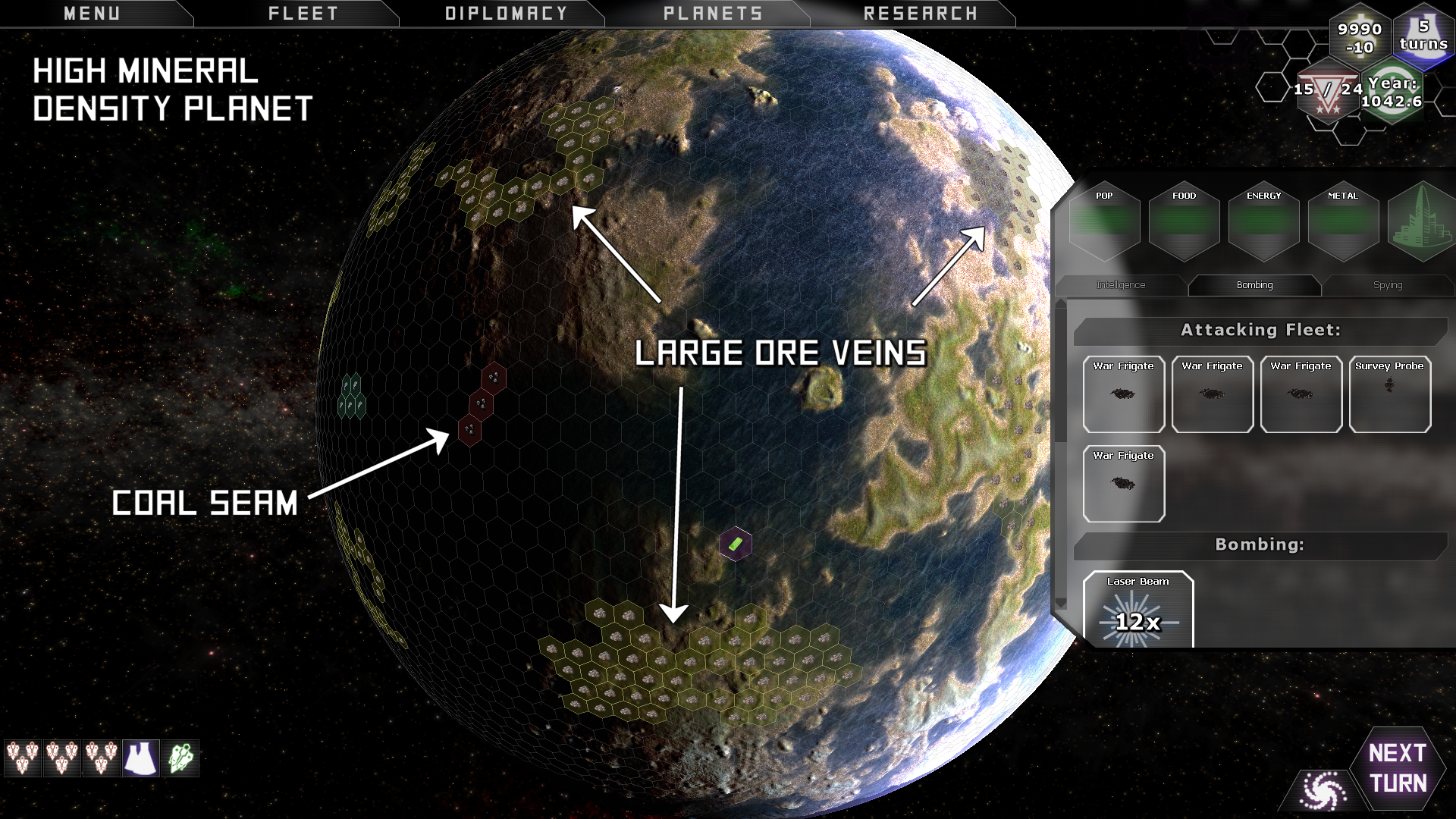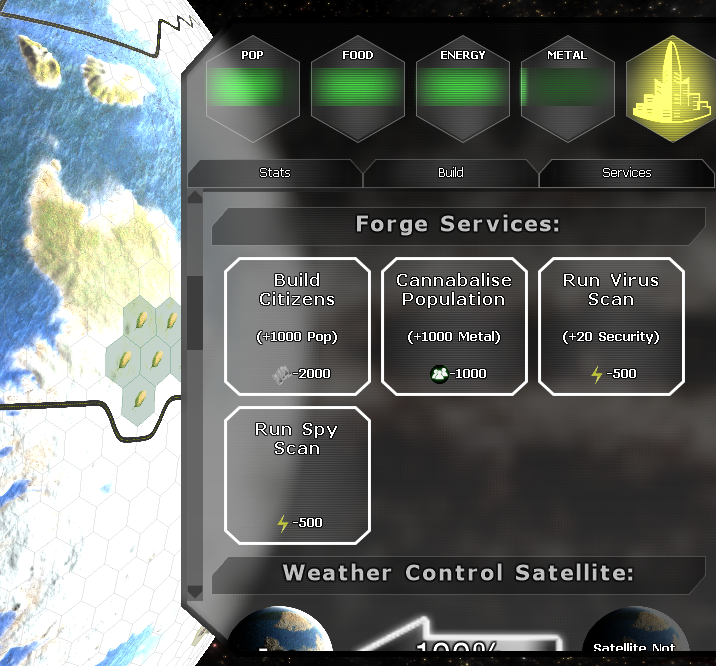For the past few months we’ve been working on some big features and AI upgrades for Predestination, which have now been deployed as Update V0.9.6.0. This update includes the Spying gameplay and its associated technologies, advanced new weapons designed by some of our Kickstarter backers, planetary resource distribution improvements, and a brand new War AI system that intelligently selects targets and wages war against enemy nations. Also included in this update is a revised version of the morale, security and health systems, robotic race improvements, Galaxy AI improvements, and a huge number of bug-fixes and other changes.
This update paves the way for us to start work on the final major features for the game before we are feature-complete: The first episodic storyline mission, mission-modding capabilities, and the unfinished Fleets and Planets dropdown menus. We’re working hard on getting these features complete as quickly as possible and will be deploying them as V0.9.7.0, and after that all we should have left before we’re at the main version 1.0 release is content such as additional races of ship models, more random events and disasters, some new technologies, Kickstarter backer content, and UI improvements. At the same time, we can focus on polishing and iterating based on your feedback and get ready for the main launch and to get started on free post-release updates.
In this dev update, I’ll go into detail on everything in version 0.9.6.0 and talk a little about what’s coming in 0.9.7.0.
We discussed the spying gameplay in detail back in July, when we decided to move it from the planned features list into the main game release due to popular demand. The Spying gameplay is now live in 0.9.6.0 and is mostly the same as what was previously announced, with a few mechanics changing from the previous plan. The old system required you to send spies on individual missions, which turned out to be very micromanagement-heavy and easy to lose track of and had to be re-designed to be more passive.
In the final implementation, you still pay 100 BC to insert a spy from a spy ship into a city, and you still pick which mission you want the spies on that planet to attempt. Each mission now costs a certain amount of money per turn instead of a lump sum, and your spies continually attempt that mission until you switch missions or they are caught. To support this, we’ve combined several of the missions together to make the choice more logical:
- Hide: “Infiltrate the planet and lay low awaiting further orders. All spies gain +1 infiltration rating each turn, with the possibility of establishing contact with criminal and subversive elements in the target planet’s society for a surprise 25% bonus once every 10 turns.” This is the default mission and costs 0 BC/turn.
- Hack Computers: “Hack the planet’s computer systems to steal important data. Spies may steal the enemy’s maps of the planet, money from the treasury, research points from the scientific network, or even complete technologies.”
- Sabotage Computers: “Introduce a virus into the planet’s computer systems, disrupting planetary activities. This may destroy research points, shut down infrastructure, reduce planetary morale, reduce the planet’s health rating, or reduce the planet’s security rating.”
- Plant Bombs: “Attempt to plant bombs inside cities, buildings, infrastructure, starbases, and ships in orbit of the planet. This mission carries the increased risk that the spy may blow himself up in the destruction.”
- Incite Civil Unrest: “Attempt to incite civil unrest and rebellion among the population, reducing the morale and security ratings of the planet temporarily. If the planet’s loyalty rating drops low enough, the planet may even defect to your empire”
- Assassinate Leader: “Attempt to assassinate the legendary planet leader currently stationed on this planet.”
Above is the user interface for spying, showing two infiltrated spies and some of the missions available, along with their costs per turn and estimated chances of success. The spy will attempt his mission every 10-25 turns and a failed mission has a 25% chance to result in your spy being caught and killed by the enemy security forces. A caught spy will cause a diplomatic incident, costing you favour with the enemy race, treaties to be cancelled, and even war to be declared if your favour is low enough. We’ve also added some new spying technologies as part of this update:
- Atomiser Implant: Spies are equipped with an implant that completely atomises the body on death and leaves no trace. If your spies are caught during a mission, the enemy race will not be able to prove that the spy belonged to your race and there will be no negative diplomatic actions.
- Computer Hacking: Spies can be trained in advanced computer hacking techniques, providing a +20 bonus to the Hack Computers spy mission and a +20 bonus to defense against enemy hacks. A successful hack attempt will steal planetary maps, money, research points, and even full technologies.
- Spy Satellite: The Spy Satellite probe is an unmanned stealth probe fitted with an FTL drive and advanced camera equipment. It can be installed in orbit of an enemy planet in order to perform surveillance spy tasks and give your spies a +50 bonus to all spy actions for 100 turns.
- Neural Interface: The Neural Interface ship module allows a ship’s captain to directly interface with the ship’s systems, doubling the bonuses provided by any Legendary Captain aboard the ship. Spies can also use this technology to access computer systems more effectively, giving a +10 bonus to all spying actions.
.
This patch included an overhaul of terraforming weapons and several new ship weapons and modules designed by our Kickstarter backers, plus a few changes to existing weapons. The Plasma Mine Layer was a little bit rubbish as the AI just avoids them, so we improved it to deploy a small field of mines instead of just one at a time so you can surround a ship in mines or use them to block off an area.
We’ve added the Titan ship hull to the game, which is now the largest ship hull in the game with 1350 base armour, 2100 base power output. A larger Dreadnought ship hull size was originally planned but it didn’t fit the current technology progression and wasn’t very practical to build or control in Fleet Combat, so we removed it and buffed the Titan instead. Below is information on all of the new ship weapons and modules:
- Plasma Storm Bomb: Reduced from 200 damage to 100 and added the secondary effect of creating Electrodynamic storms in the planet’s atmosphere, making it impossible to run any factories and ore refineries for 5 turns. This can help you stop an enemy from rebuilding as you lay siege to his planet.
- Empulsor Device: An Electromagnetic Pulse device powered by an anti-matter reaction and designed for planetary bombardment. The Empulsor bomb can be dropped anywhere on a planet and will immediately shut down all infrastructure and orbital structures on the planet for the next two turns. The device gives off harmful radiation and is only suitable for use on unmanned warp-capable missiles.
- Disassembler Bomb: The Disassembler Bomb contains a breed of destructive nanites enclosed in a standard bomb casing. When used to bombard an enemy city, the nanites seek out and disassemble a piece of infrastructure connected to the city, turning it back into raw materials. Half of the metal used to build the structure is reclaimed by the planet’s owner.
- Graviton Field Emitter: By shunting high-energy plasma through a sustained graviton emitter, the Graviton Field Emitter ship weapon creates an uncontrolled graviton field on the battlefield. The field deals 20 damage to all ships in its area of effect each turn, slows all ships in its area of effect, and lasts until the end of combat.
- Proto-Wormhole Generator: By interleaving two opposing graviton fields, the Proto-Wormhole Generator ship weapon causes a localised spatial displacement, sending any ship in the selected hex to a random unoccupied position on the battlefield. The weapon has to cool down for 3 combat rounds between uses.
- Quantum Destabiliser: The Quantum Destabiliser uses a modified tractor beam to scramble the enemy ship at the molecular level, causing components to fuse and short circuit. The beam deals 10 damage directly to a ship’s armour, bypassing any shields, and increases by 10 damage each turn until the target ship is destroyed or the beam is terminated. Each Quantum Destabiliser weapon can be active on only a single ship at a time.
- Psionic Flux Phaser: The Psionic Flux Phaser is a ship weapon that uses psionic frequencies to transmit thoughts and propaganda directly into the minds of enemy crewmen, disorienting them during the battle and causing them to make mistakes. The affected ship’s engines, weapons, or shields will be disabled for 3 turns.
- Fleet Heart: The Fleet Heart is a power-hungry ship module that uses quantum entanglement to link together the computers of every ship in a fleet and share sensor data in realtime. Every ship in the fleet benefits from +20% damage and a +10% chance to dodge incoming attacks while a ship carrying a Fleet Heart is operational. Only one Fleet Heart can be fitted to a ship, and the effects of multiple Fleet Hearts in the same fleet don’t stack.
- Habitation Module: Contains living space, hydroponic farms, and facilities for 2,000 citizens. When stationed in a friendly star system, the self-contained miniature city will produce 4 BC, 50 metal for one planet in the star system, and +10 morale for all planets in the system each turn. If it ever gets destroyed then you’ll suffer a -20% morale hit on all planets across your empire.
Terraforming weapon overhaul:
- Dessication Device (Reptilian Only): The Dessication Device is a low-yield bomb that introduces a self-replicating crystalline structure into the oceans of the target world, where it absorbs water and locks it away underground to reduce the sea levels. The planet’s climinate will become 10% closer to Desert status, making it more habitable for Reptilian species and less habitable Humanoid, Aquatic, and Robotic races.
- Liquefaction Device (Aquatic Only): The Liquefaction Device is a low-yield bomb that spreads catalytic nanoparticles throughout the atmosphere of a habitable planet, combining free oxygen and hydrogen into water in order to raise the sea levels. The planet’s climinate will become 10% closer to Ocean status, making it more habitable for Aquatic species and less habitable Humanoid, Reptilian, and Robotic races.
- Weather Stabiliser (Humanoid Only): The Weather Stabiliser is a low-yield bomb that spreads biological catalysts throughout the upper thermosphere of a habitable planet to stabilise the planet’s weather patterns and promote diverse ecologies. The planet’s climate will become 10% closer to Terran status, making it more habitable for Humanoid species and less habitable Aquatic, Reptilian, and Robotic races.
- Smogger Bomb (Robotic Only): The Smogger is a low-yield bomb that spreads light-blocking particles of carbon soot and dust throughout the atmosphere of the target planet, reducing the global temperature and attempting to trigger an early ice age. The planet’s climate will become 10% closer to Ice status, making it more habitable for Robotic species and less habitable Aquatic, Reptilian, and Humanoid races.
- Genesis Device: A metastable biological catalyst in a standard bomb casing, capable of completely wiping out all life on a planet and re-generating it as a paradise for your species. The Genesis Device can be launched at any planet, instantly transforming it into a Terran world and destroying all structures. The Genesis Device is a single-use warhead that can only be fitted to warp-capable Missiles. Use of this device on colonised planets may incur a diplomatic penalty with other races.
.
Every part of Predestination’s gameplay has an accompanying artificial intelligence module that makes decisions using the same kinds of criteria that a player would use, and the interplay between these AI modules often leads to unexpected emergent results. When we implemented the War AI system we found that the AI sometimes made some odd decisions such as asking for peace with a race shortly after declaring war on them, or two races both invading each other’s planets rather than defending what they’ve already got.
Complex AI is tricky to debug, but after spending some time setting up in-game scenarios to test the AI’s reactions, we managed to figure out what was causing most of these odd quirks and solved them with a new AI Goal system that operates in distinct phases. All races start with the goal of expanding their empire rapidly and then later switch to other goals depending on the circumstances that they find themselves in. The AI continually re-assesses its military strength, diplomatic relationships, and empire metrics compared to the other races in the game and makes its decision on what goal it should pursue based on that. The five goals it can use are:
- Expand: This is the default AI goal and instructs the race to prioritise outward exploration and expanding into new star systems. This is analogous to the Explore and Expand phases of a typical 4X game.
- Consolidate: Prioritises colonisation of suitable planets in star systems you’ve already colonised, and building up all of the existing planets. The Consolidate goal is typically triggered by other races encroaching on the AI’s territory, and is analogous to the Expand and Exploit phases of a typical 4X game.
- Diplomacy: Prioritises diplomatic contact and advancing its race’s technology and status within the galaxy rather than simple expansion and colonisation. This goal also includes building up more military defences to act as pressure in diplomacy, and is analogous to the Exploit and Exterminate phases of a typical 4X game. The AI currently only does simulated diplomatic deals with each other and not with the player, but this is coming in a future update.
- Defend: Prioritises building up military defences and slow down its colonisation. It’s often triggered by the presence of a more powerful race threatening the AI’s borders and is analogous to the Exploit and Exterminate phases of a typical 4X game.
- Conquer: Prioritises declaring war on another race and invading its planets, as well as building military defences and attack ships. This goal is typically triggered when a race has assessed that it’s more powerful than the other races in the game, and is analogous to the Exterminate phase of a typical 4X game.
Giving the AI these overarching goals that influence its behaviour in all aspects of the game was enough to make their gameplay a lot more cohesive and player-like, and we also took the opportunity while working on this to refine some of the rules the AI uses to make its decisions. The AI now has added incentive to colonise planets with strategic resources, specials such as crashed alien ships or ancient civilisations, and star systems with wormhole connections. They also now build ships in up to 3 shipyards simultaneously rather than just building in their best shipyard and leaving the others empty, and we’ve improved how the AI values Peace and Alliance treaties. Below is a screenshot of the new AI goals and debug panel, a new tool that helps me to figure out bugs in the AI by showing some of the stats it uses in the decision-making process.
.
War Declaration: The AI races now periodically assess whether they should declare war on another race using parameters such as fleet strength, strategic weaknesses in the enemy planets, their current favour level, the difficulty setting, and the personality type of the race’s randomly generated leader. The AI also now automatically declares war if you bomb their planets or attack their fleets.
Strategic Analysis: When in a war, the Strategic Analysis AI will periodically analyse the enemy planets for strategic weaknesses and compare the strength of its own fleets to the strength of your fleets and planetary defences, also taking into account all the ships that could reach the target system in time to defend against attack. It will put together fleets it thinks can defeat a target planet or fleet and dispatches them to attack.
Bombardment and Capture: The AI is now capable of bombing enemy planets and launching troops to capture them. After a successful attack on a planet, the AI will then continually bomb it until it runs out of ammo, destroys/captures the planet, has to return home to defend another planet, or is repelled by enemy forces. This can lead to long sieges and blockades if you have city shields, and the AI may dispatch additional ships or find a weaker target.
Defensive Deployment: The Defensive Deployment section of the War AI deploys an empire’s ships based on an assessment of nearby threats. It works out how many enemy ships could reach each star system, assesses the threat they pose (modified by whether they are at war or have a peace treaty or alliance) and sends enough ships to defend. This naturally tends to deploy ships around the race’s borders and concentrates them near other races they are at war with. This part of the AI was already implemented, and has now been refactored and absorbed into the War AI code.
Bid For Peace: The War AI continually re-assesses how its current wars are going and can decide to bid for peace with the enemy race. It will generate an offer that it thinks the enemy will accept, which may contain technologies and money to sweeten the deal. If the race is losing the war and it’s absolutely hopeless and they think they’re never going to be able to secure a peace treaty, they can sometimes even surrender to another race. All assets and planets are transferred over to the new race on surrendering, and a special diplomacy event announces it.
.
We’ve made some improvements to how planets generate resources in response to recent feedback from the Steam discussion forums. It was pointed out that planets with higher mineral ratings had more deposits of Ore but that there was no guarantee that they would be closely grouped together so you could end up with a lot of ore refineries with 4 or fewer deposits in them. There were enough deposits to run several full-scale industrial cities, but if you ran a specialised setup with just 1-2 industrial cities those cities wouldn’t be any better than those on other worlds.
To solve this problem, we re-designed the resource distribution mechanics to group deposits together into larger clumps, so now veins of ore on mineral dense planets can now extend over a large portion of a continent. We’ve also applied this new strategy to other resources, so coal can now generate in small clusters and organic-rich planets will now roll patches of fertile soil, fish for Ocean/Swamp planets, and Land Animals for Terran planets. This will let you get more out of a planet and will also help you decide where to place cities as the resources are less spread out over a planet’s surface.
.
The Morale, Security, and Health systems have been overhauled as part of implementing the Spying gameplay and War AI. In the old system, planets had flat values for each of these stats based on factors such as tax rate and buildings on the planet, and the only way to change them was to change those factors. In the new system, Morale, Security and Health are now resources that can be increased or decreased over time or reduced in chunks by special events or weapons. We’ve been following the feedback on this feature since the patch went live and are eager to hear any thoughts you have on the system after playing with it. Does it make sense, is it too chaotic, is the tax system fair, does the UI need tooltips to give a breakdown of the stats, etc?
Tax Rate: Population tax rate now decreases the morale per turn in each city by -1% per 10% tax rate. This means planets with more cities will be affected more by tax, but building one extra entertainment center per city will allow you to raise tax rates by 10%. We hope that this system is easier to work with than the previous one, but we’re open to discussion on it if it’s confusing.
Technology Changes: All technologies and buildings that affect Morale, Security and Health now have been modified to provide bonuses per turn rather than flat values. A full list of the changes can be found in the patch notes for this update on the Steam forum.
Disaster/Weapon Changes: As part of the overhaul, we’ve added new disasters that can be triggered at the 75%, 50%, and 25% levels for Morale, Security, and Health ratings. For example, minor virus outbreaks can occur at 75% health rating, widescale disease outbreaks can happen at 50%, and an epidemic can trigger when below 25%. This update also opens the door to allow tactical weapons and spy missions to cause damage directly to the Morale, Security, and Health ratings of a planet.
Planet Defections: The Loyalty stat works just the same as before, increasing by +1 per turn for each of the stats (Morale, Security and Health) above 50% and reducing by -1 per turn for each of the stats below 50%. If a planet’s Loyalty stat ever drops to 0, the planet will defect to another empire in the game.
.
While developing this update, we noticed that Starforged performed quite poorly when controlled by the Galaxy AI, so we took some time out to improve the Robotic race gameplay and add some new technologies for them. Robotic races can now build new population using only metal (no more coal/food required), and a bug preventing them from building new population when near the planetary maximum has been fixed. Robotic race AI also now use their lack of farming and residential city requirements to their advantage — building more Defense cities.
A new Robot Deconstruction technology allows you to salvage 1,000 population and get back half the metal used in their construction. We’ve also added a number of new Forge Patch technologies, which are abilities that can be activated from a planet’s Services panel and cost energy from the planet’s reserves. The “Forge Patch: Antivirus” technology increases security on the planet by a flat 20 points, and the “Forge Patch: Spy Scan” will reveal enemy spies and has a 25% chance to kill one spy.
.
As part of our original Kickstarter campaign’s stretch goals, we promised to add an episodic singleplayer campaign mode and some interesting challenge maps to the game. We hope to include the very first singleplayer mission in the next major update (V0.9.7.0). We’ve already broadly designed how we’re going to implement singleplayer missions and written the first draft of the storyline, and now we’re implementing all of the mechanics along with support for modding and the remaining two dropdown menus:
Singleplayer Missions: Each singleplayer mission will be broken down into a series of Stages, each of which has a number of goals you have to achieve to progress to the next stage. Some goals will be optional but give you more victory points at the end of the mission, and others will be mandatory so you’ll fail the mission if you don’t complete them. Each stage will be prefaced with some storyline exposition or discussion with another alien race that advances the story, and we’re hoping to be able to voice act all of these either in this patch or a future release. As we discussed in the previous dev update, the story we have planned is broken down into two main story arcs — The first follows the story of each race before the Revenant war and has a mission for each race, while the second follows what happens to each of the races after being sent back in time and will contain the canonical ending for the game.
Mission-Modding: The mission system is going to load all of the relevant information for a mission from flat files within a directory in the game files. This will allow players to modify the missions or add their own easily. Mission modding will include the ability to override the game’s standard technology trees, planet leaders, ship captains, weapons, modules, etc. Mission modders will also be able to decide the spawn rules for the map, mission objectives, dialogue, and graphics.
Dropdown menus: The Planets and Fleet dropdown menu still need to be implemented, and we’re hoping to get that done for this update if possible. These dropdown menus will provide at-a-glance overviews of your planets, ships, and shipyards, and will act as shortcuts to help you navigate a sprawling empire as it grows. This feature may not be completed in V0.9.7.0, but if we make good time on the singleplayer then there may be time to implement it.
.
Thanks for reading this dev update, and for your support of Predestination’s development. As always, we welcome any and all feedback on the contents of the update or the game via our Steam forum, Kickstarter/blog comments, or via email to brendan@brainandnerd.com if you’d like to keep your feedback private. We’ll be sending out the next wave of invites to Kickstarter backers who have recently requested them today. If you’re a Kickstarter backer and haven’t received your copy of the game yet but would like to get it now, send an email to earlyaccessrequest@brainandnerd.com with the email address you used on Kickstarer and we’ll send you either a Steam code or a link to the latest non-Steam DRM-free version, whichever you prefer.
Cheers,
— Brendan, Lead Developer








